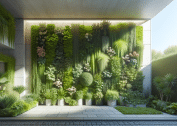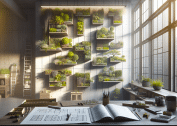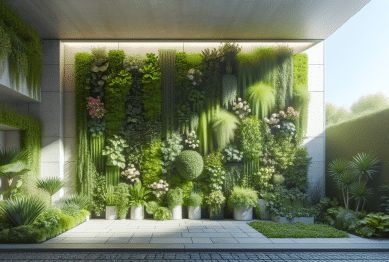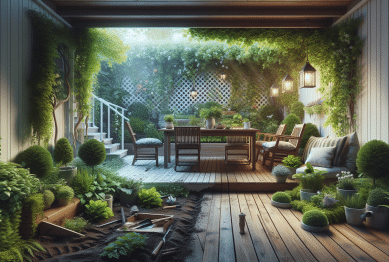Exploring unique ways to enhance your garden can unlock creative possibilities and long-term value. This guide unpacks practical, eco-friendly garden design strategies, low-maintenance landscaping, and tips for maximizing space, helping you achieve a relaxing outdoor retreat that suits any lifestyle.
Making the Most of Small Garden Spaces
Small gardens offer opportunities to be resourceful and intentional with every feature. Embracing vertical gardening is a strategy that can quickly expand growing potential. Utilize trellises, wall planters, and hanging baskets to lift greenery upwards, freeing valuable ground for other uses. Such approaches allow compact outdoor areas to burst with herbs, flowers, and even vegetables. This technique doesn’t just solve space limitations—it often leads to healthier plants by improving airflow and sunlight exposure, which can minimize risks of diseases and pests (Source: https://extension.psu.edu/vertical-gardening).
Strategic planting is another key to small garden success. Using containers or raised beds can simplify soil management and enable easy relocation of plants to accommodate sunlight or seasonal needs. By combining low-maintenance plants with ornamental ones, a dynamic setting is achieved without sacrificing ease of care. Many homeowners discover that layering plant heights and types creates the illusion of a larger, more abundant garden, which also encourages useful pollinators like bees and butterflies to visit (Source: https://edis.ifas.ufl.edu/publication/EP426).
Don’t overlook multipurpose garden furniture. Foldable benches, storage ottomans, or raised decks can double up as seating and tool storage. Even small water features, like a tabletop fountain, can add tranquility without crowding the landscape. Thoughtful planning and space-saving solutions allow anyone to create an inviting retreat—even in a tiny backyard or on a balcony.
Eco-Friendly Approaches to Garden Design
Eco-friendly gardens blend beauty with responsibility. Native plant selections support local biodiversity while reducing the need for fertilizers and frequent watering. Rain gardens use natural dips in the landscape to capture and filter stormwater, preventing runoff and erosion. Permeable paving offers a sustainable alternative to traditional concrete paths, welcoming rain into the soil and reducing the strain on municipal systems (Source: https://www.epa.gov/green-infrastructure/what-green-infrastructure).
Composting is a cornerstone of sustainable gardening. By turning kitchen scraps and yard waste into nutrient-rich soil amendments, gardeners help close the loop on organic waste. A simple compost bin or pile is easy to maintain and can supply valuable nutrients to flower beds or vegetable plots. Over time, this reduces reliance on chemical fertilizers and supports overall plant health, boosting blooms and yields with natural ingredients (Source: https://extension.umn.edu/how-manage-soil-and-nutrients-home-gardens/composting-home).
Water conservation is another priority. Soaker hoses, drip irrigation, and mulching can dramatically lower water usage while keeping roots healthy. Selecting drought-tolerant plants further enhances resilience, particularly in regions facing changing rainfall patterns. These methods not only benefit the environment—they often save time and money in the long run.
Secrets to Low-Maintenance Landscaping
Designing a low-maintenance garden is about making smart initial choices. Focus on slow-growing shrubs and groundcovers that require little pruning or mowing. Select perennials that thrive year after year, so seasonal planting and digging are kept to a minimum. Group plants according to their sunlight and water needs. This enables efficient irrigation and simplifies ongoing care (Source: https://www.gardeningknowhow.com/special/urban/low-maintenance-garden.htm).
Mulching beds with bark, gravel, or recycled materials suppresses weeds, retains soil moisture, and enriches the look of a garden. Many gardeners opt for decorative stones or synthetic turf in high-traffic areas to further cut down on upkeep. Timed irrigation systems or weather-based watering apps can also streamline routine chores and promote healthy growth without constant oversight.
Consider automating some tasks. Solar lights, self-watering containers, and motion-sensor sprinklers offer modern solutions for hands-off enjoyment. By focusing on these low-effort features, outdoor spaces stay impressive throughout the seasons, granting more relaxation and less manual maintenance.
Boosting Curb Appeal With Creative Enhancements
First impressions count. Eye-catching landscaping details can elevate curb appeal and increase overall property value. Framing sidewalks or entryways with flowering borders creates a welcoming vibe. Mixing perennial color schemes with evergreens ensures year-round interest. Installing a striking entry gate, modern mailbox, or pathway lighting instantly refreshes the home’s exterior appeal (Source: https://edis.ifas.ufl.edu/publication/EP375).
Adding artful touches makes a garden unique. Consider sculptural planters, mosaic stepping stones, or upcycled accent pieces. These focal points provide personality and focal interest. Many homeowners experiment with color through painted furniture, whimsical signage, or even temporary floral arrangements for seasonal variety and visual flair.
Local wildlife can also enhance the ambiance. Bird feeders, butterfly habitats, and native hedges invite movement and sound into the garden. Not only do these additions attract helpful pollinators, but they also connect the space with the local ecosystem, turning any garden into a personal haven and natural refuge.
Maximizing Outdoor Living Spaces for Comfort
Gardens are increasingly seen as outdoor rooms—extensions of indoor living areas. Designing cozy patios, shaded decks, or open-air dining nooks provides additional space for relaxation and entertaining. Selecting weather-resistant furniture and textiles ensures durability, while lush container gardens and privacy screens create intimate, inviting settings (Source: https://www.todayshomeowner.com/gardening/guides/outdoor-living-ideas/).
Outdoor kitchens, fire pits, and pergolas add comfort and versatility. These features transform the garden into a hub for socializing and family gatherings. Adding dimmable LED lighting, string lights, or lanterns extends enjoyment well into the evening, letting the garden glow with atmosphere and warmth.
Many homeowners integrate technology, like wireless speakers or smart irrigation systems, for extra convenience. The result: personalized outdoor environments that blend modern comforts with natural beauty, supporting leisure and well-being all year long.
Planning and Budgeting Your Garden Transformation
Starting any garden makeover requires careful planning. Begin by assessing what is already available and what improvements will provide the most impact. Sketch a layout, noting sun exposure, existing plants, and flow between indoor and outdoor spaces. Set clear goals, such as increasing shade, adding a vegetable patch, or making the garden pet-friendly.
Budgeting is crucial. List potential materials, plants, and features, then research estimated costs from local suppliers and garden centers. Many communities offer resources or workshops on sustainable landscaping and affordable gardening techniques. Comparing prices and sourcing native plants locally can reduce expenses without compromising quality or design aspirations (Source: https://www.ahs.org/gardening-resources/garden-planning-and-budgeting).
Consider phasing larger projects. Breaking a transformation into manageable stages helps spread costs, adapt plans based on experience, and celebrate each new milestone. The most successful gardens evolve over time—shaped by inspiration, climate, and personal enjoyment. Every stage is a step closer to a truly unique and comfortable retreat.
References
1. Pennsylvania State University Extension. (n.d.). Vertical Gardening. Retrieved from https://extension.psu.edu/vertical-gardening
2. University of Florida IFAS Extension. (n.d.). Designing Your Florida-Friendly Landscape. Retrieved from https://edis.ifas.ufl.edu/publication/EP426
3. United States Environmental Protection Agency. (n.d.). What is Green Infrastructure? Retrieved from https://www.epa.gov/green-infrastructure/what-green-infrastructure
4. University of Minnesota Extension. (n.d.). Composting in the Home Garden. Retrieved from https://extension.umn.edu/how-manage-soil-and-nutrients-home-gardens/composting-home
5. Gardening Know How. (n.d.). Urban Low Maintenance Gardens. Retrieved from https://www.gardeningknowhow.com/special/urban/low-maintenance-garden.htm
6. American Horticultural Society. (n.d.). Garden Planning and Budgeting. Retrieved from https://www.ahs.org/gardening-resources/garden-planning-and-budgeting









